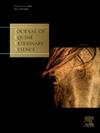Effect of hay nets on subluxations, pain-pressure thresholds, and cervical range of motion in the axial skeleton of adult horses
IF 1.3
3区 农林科学
Q2 VETERINARY SCIENCES
引用次数: 0
Abstract
Horses have become more intensively managed, including the use of hay nets to increase intake time and reduce hay waste, but their impact on health is not well known. The objectives were to compare changes in subluxations, range of motion, and the pain-pressure threshold in the axial skeleton of horses fed hay with (NET) or without (CON) hay nets. In September 2021, 13 adult horses were blocked by bodyweight (BW) and randomly assigned to the NET or CON treatments for one year. After one year, horses switched treatments and the trial concluded in September 2023. Horses were housed in dry lots with free choice access to round bales with or without hay nets (4.45 cm openings). Chiropractic adjustments occurred in May and August each year to note axial skeleton subluxations. Evaluations occurred in June, July, and August to measure cervical range of motion and mechanical nociceptive thresholds (MNTs) of the jaw, poll, and withers. SAS was used and significance was set at P≤0.05. There was an average 1.6-point increase in cervical subluxations observed in NET horses (P<0.05) while no changes were observed for the TMJ and thoracic or lumbar vertebral regions (P>0.05). Average cervical range of motion was 5 degrees greater in NET horses compared to CON horses for chin to chest and chin to fetlock measurements (P≤0.05). No differences were observed in MNTs (P>0.05). These data suggest that netted round bales may only have minor impacts on the axial skeleton of horses over 12-weeks.
干草网对成年马轴骨半脱位、疼痛-压力阈值和颈椎活动度的影响。
马已经变得更加集约化管理,包括使用干草网来增加摄入时间和减少干草浪费,但它们对健康的影响尚不为人所知。目的是比较用(NET)或不用(CON)干草网喂干草的马的半脱位、活动范围和轴向骨骼痛压阈值的变化。2021年9月,13匹成年马被体重(BW)封锁,随机分配到NET或CON治疗一年。一年后,马匹换了治疗方法,试验于2023年9月结束。马被安置在干燥的空地上,可以自由选择是否使用有或没有干草网的圆捆(开口4.45厘米)。每年5月和8月进行捏脊调整,以注意轴向骨骼半脱位。评估在6月、7月和8月进行,以测量颈椎活动度和下颌、poll和肩隆的机械伤害阈值(mnt)。采用SAS分析,P≤0.05为显著性。NET马的颈椎半脱位平均增加1.6个点(P0.05)。与CON马相比,NET马的平均颈椎活动范围在下巴到胸部和下巴到脚镣的测量上大了5度(P≤0.05)。mnt无差异(P < 0.05)。这些数据表明,在12周内,网状圆捆可能对马的轴向骨骼只有轻微的影响。
本文章由计算机程序翻译,如有差异,请以英文原文为准。
求助全文
约1分钟内获得全文
求助全文
来源期刊

Journal of Equine Veterinary Science
农林科学-兽医学
CiteScore
2.70
自引率
7.70%
发文量
249
审稿时长
77 days
期刊介绍:
Journal of Equine Veterinary Science (JEVS) is an international publication designed for the practicing equine veterinarian, equine researcher, and other equine health care specialist. Published monthly, each issue of JEVS includes original research, reviews, case reports, short communications, and clinical techniques from leaders in the equine veterinary field, covering such topics as laminitis, reproduction, infectious disease, parasitology, behavior, podology, internal medicine, surgery and nutrition.
 求助内容:
求助内容: 应助结果提醒方式:
应助结果提醒方式:


